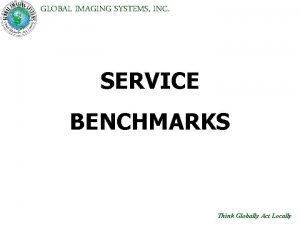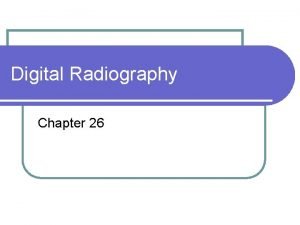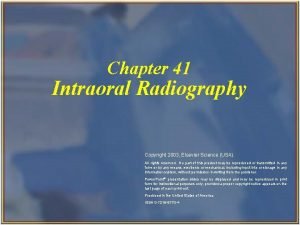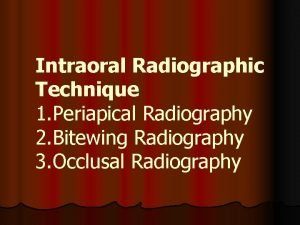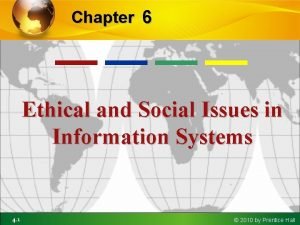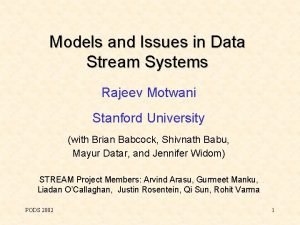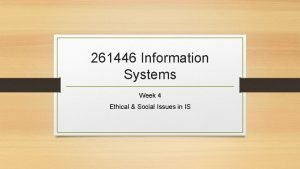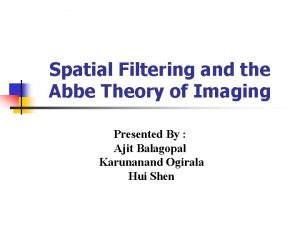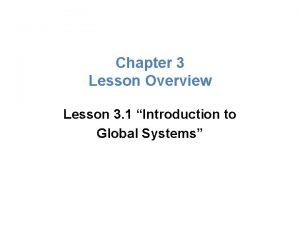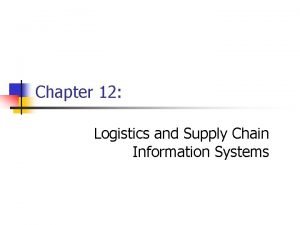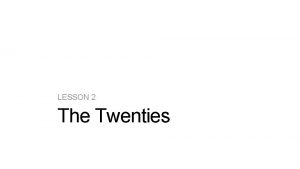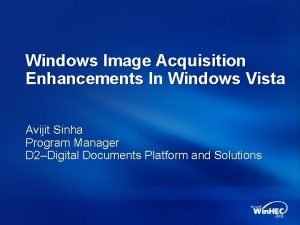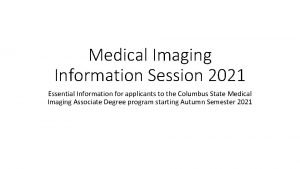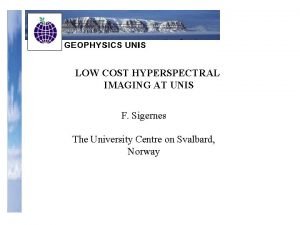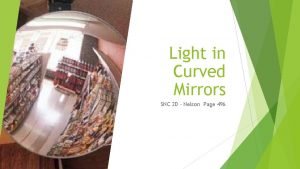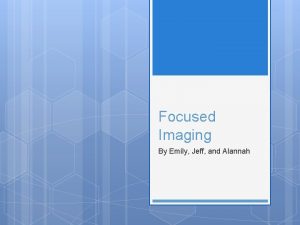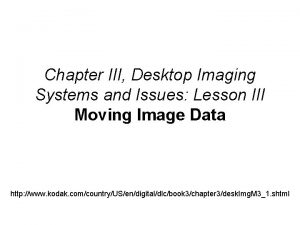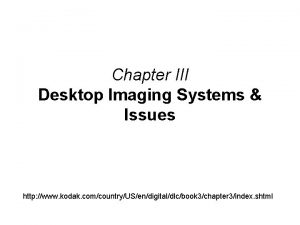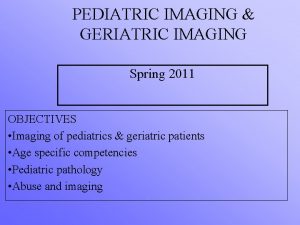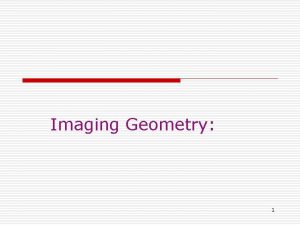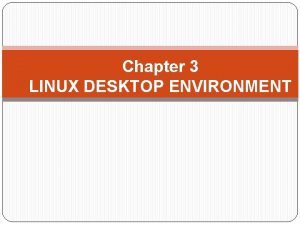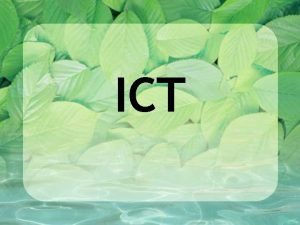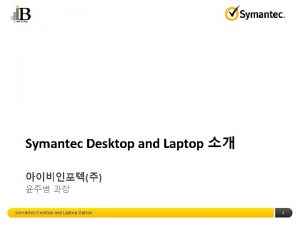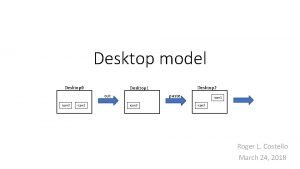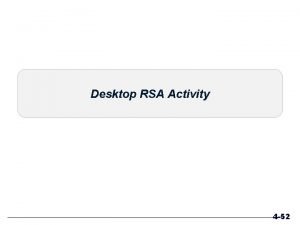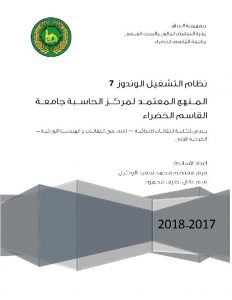Chapter III Desktop Imaging Systems and Issues Lesson




























- Slides: 28

Chapter III, Desktop Imaging Systems and Issues: Lesson IV Working With Images http: //www. kodak. com/country/US/en/digital/dlc/book 3/chapter 3/desk. Img. M 4_1. shtml

Working with digital images requires a working knowledge of the methods used for encoding images for the computer. These encoding methods include file formats, page description language, and compression schemes.

Image file formats can be either raster or objectoriented.

Raster files, or bit-mapped data, are created by scanners and digital cameras. Raster files store images as a matrix of picture elements called pixels. This type of file is used when digitally processing photographic images.

The quality of a raster image is determined at capture by two factors: spatial resolution and brightness resolution.

Spatial resolution is determined by the rate at which the scanner samples the image. The higher the resolution, the higher the quality, but also the larger the file.

The brightness or color value of each pixel is defined by one bit or by a group of bits. The more bits used, the higher the brightness resolution.

Object-oriented files, also known as vector files, describe the contents of an image in mathematical or algorithmic terms. These types of image files are typically used in graphic arts and illustration applications.

Vector images are stored as a display list describing the location and properties of objects making up the image. Objects can include: 1. The letter "A", in Times font, bold, 14 point 2. A circle, 2 inches in diameter, with a line-width. 2 inches 3. A raster image scaled to 2 by 3 inches

Page description languages, such as Postscript, are a type of object-oriented file in which a programming language is used to define the text, vector graphic, and bitmapped image content of the page.

A Post. Script file can be scaled to any resolution and output to any Post. Script printer, imagesetter or film recorder.

For printing at a given resolution, a Raster Image Processor, or RIP is needed. A RIP is the part of a laser printer, film recorder or imagesetter which reads and interprets the page description language, and renders a raster form of the page for printing.

Raster Image Processors are typically built into a postscript printer. However, in some cases RIPs can be standalone devices with processing power and memory comparable to the computer.

Image compression uses mathematical techniques to allow an image to be stored in less memory by removing redundancies in image data.

There are three basic types of image compression: lossless, lossy, and visually lossless.

Lossless compression achieves only about a 2 to 1 compression ratio, but the reconstructed image is mathematically and visually identical to the original.

Lossy compression provides much higher compression rates, but the reconstructed image shows some loss of data compared to the original image.

JPEG, a common lossy compression scheme, offers a range of compression ratios. Depending on image content, an image file can be compressed to about one tenth the original size without noticeable degradation.

Visually lossless compression, based on information about color images and human perception, sorts image data into "important data" and "unimportant data, " then discards the unimportant data.

Photo CD uses a type of visually lossless compression called chroma decimation. An image is separated into detail and color information. Chroma decimation then discards visually unimportant color information.

Photo CD further reduces image file size through a combination of lossy and lossless compression called hierarchical encoding. This type of encoding makes several files at different resolutions for different display and printing applications.

Compression becomes important when sending images to different locations. For example, compressing an image before sending it via modem saves time and cost.

When archiving images, some level of compression can save space and cost without sacrificing image quality.

To conclude this module, a quick look at image processing will shed some light on why some imaging operations place greater processing demands on the system than others.

When an image is rotated or flipped, the data in the image file is merely reordered. Pixels are moved or rearranged. Pixel values are not changed.

When the brightness, contrast, or the color tone of an image is adjusted, a mathematical formula calculates new pixel values. The position of pixels or their quantity is not changed.

Resizing an image changes the number of pixels in the image. For instance, to reduce an image by half in each direction, the computer divides the image into four-pixel blocks. It then replaces each block with a single pixel whose value is averaged from the four pixels.

Filtering operations used to sharpen or blur an image are processing-intensive. In these operations, a block of pixels must be weighted, then summed to calculate each new pixel value.
 Frc control system
Frc control system Global imaging systems inc
Global imaging systems inc Chapter 4 ethical issues
Chapter 4 ethical issues Chapter 4 ethical and social issues in information systems
Chapter 4 ethical and social issues in information systems Hamlet act iii scene ii
Hamlet act iii scene ii Chapter 39 digital imaging film and radiographs
Chapter 39 digital imaging film and radiographs Chapter 39 digital imaging film and radiographs
Chapter 39 digital imaging film and radiographs Too much vertical angulation results in images that are
Too much vertical angulation results in images that are A grid used with extraoral imaging:
A grid used with extraoral imaging: Projected maxilla
Projected maxilla Social and ethical issues in information systems
Social and ethical issues in information systems Ethical and social issues in information system
Ethical and social issues in information system Models and issues in data stream systems
Models and issues in data stream systems Ethical and social issues in information systems
Ethical and social issues in information systems Iac princeton
Iac princeton Abbe imaging experiment
Abbe imaging experiment Chapter 3 lesson 1 introduction to global systems
Chapter 3 lesson 1 introduction to global systems Design issues of distributed system
Design issues of distributed system Contemporary issues in information systems
Contemporary issues in information systems Chapter 1 lesson 1 your total health lesson 1 quiz answers
Chapter 1 lesson 1 your total health lesson 1 quiz answers Postwar issues lesson 2
Postwar issues lesson 2 Decision support systems and intelligent systems
Decision support systems and intelligent systems What is service host windows image acquisition
What is service host windows image acquisition Gabriela barreto lemos
Gabriela barreto lemos Ohiohealth berger hospital mammography circleville
Ohiohealth berger hospital mammography circleville Affordable hyperspectral imaging
Affordable hyperspectral imaging Live cell imaging ppt
Live cell imaging ppt Imaging rules for concave mirrors
Imaging rules for concave mirrors Focused imaging learning
Focused imaging learning

